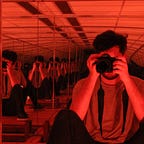FATECRAFT 1: HIGHJACKING POWER GAMES
This is the first of two of articles that intends to make Post-Architecture — as a method — more explicit and concrete. I’ve called this series FATECRAFT, and in this first post, I’ll go over some necessary essentials.
Here, I’ll try to frame Post-Architectural design as the TACTICS for the interplay between the INDIVIDUAL, its HABITS and the APPARATUSES that populate everyday life. These TACTICS exist within what can be called, for lack of a better name, a GAME OF POWER; and by recognizing the existence of such a game, one can become better at playing it — through precise and effective ontological design. So let’s begin by seeing how this “game” works.
THE APPARATUS; OR HOW YOUR CHAIR IS OPPRESSING YOU.
Consider a glass of water.
When you grab a glass of water, there is power at play, because the Glass — by means of its physical properties — constrains the ways by which you use it. The way one grabs and drinks from a glass is a power relation determined by design. The same thing happens with chairs; they are consciously designed to be the platforms for specific activities. Chairs are made to be sat on — but they are not very handy for digging holes. We can say that they “bind” you to a specific way of sitting. Of course we can get creative in how we want to use them — maybe turn them around, maybe stand on them — but their material character imposes limits to our ingenuousness. The interaction one would have with a glass or a chair has thus, enclosed within the materiality of the object, a certain type of power relation. Just try to drink water from the side of the glass that is further away from you and see what happens.
DISPOSITIFS EVERYWHERE!!
One could say that objects like the chair or the glass are “apparatuses”. Giorgio Agamben describes the concept of apparatus — or dispositif, in the original French — in the following excerpt.
“Further expanding the already large class of Foucauldian apparatuses, I shall call an apparatus literally anything that has in some way the capacity to capture, orient, determine, intercept, model, control, or secure the gestures, behaviors, opinions, or discourses of living beings. Not only, therefore, prisons, madhouses, the panopticon, schools, confession, factories, disciplines, juridical measures and so forth (whose connection with power is in a certain sense evident), but also the pen, writing, literature, philosophy, agriculture, cigarettes, navigation, computers, cellular telephones and- why not -language itself, which is perhaps the most ancient of apparatuses — one in which thousands and thousands of years ago a primate inadvertently let himself be captured, probably without realizing the consequences that he was about to face.”
Giorgio Agamben, “What is an Apparatus?”
Following Agamben, we can then say that pretty much anything can be considered an apparatus. They frame and define our subjectivities. Apparatuses and their effects of power transcend scales and materiality — they go from the very small to the very large, and in many instances physical matter does not bind them. Consider that as you read this text in the English language, bathing in the cold, electric glow of whatever screen you are using at the moment, while (probably) sitting somewhere and (probably) wearing clothes. Wherever we look, we can find instances of power relations being mediated by means of apparatuses and tools. And as we use our tools, they shape our relationship with them and with the world around us.
The TECHNOSPHERE is ubiquitous and omnipresent. Yet, it is also designable.
*
Effective Ontological Design can only come about when we accept that every apparatus — better yet, every power relation of our lives — is considered design matter.
The countless dispositifs that surround us hold a latent power that we can — and should — look at as part of the spatial designer’s agenda. But, as this dormant potential suddenly becomes designable, a need for a revaluation of the ways to approach architectural design itself arises.
Is this even Architecture anymore, given the sheer width of fields of knowledge involved? How does one approach this task? How do we design our power relations with such a varied field of apparatuses and tools? How do we program the power relations at play in people’s lives through design? How do we rewrite the “Operating System” of people’s everyday lives?
There is no “one” way. Each case is specific, and requires careful looking at on it’s own. There are also many methods to approach this task. Most of them have yet to be articulated and researched. And this is what I propose to do in this Blog. On the next posts of this series, I’ll discuss some ways of how to proceed with the endeavour to advance Ontological Design.
Post-Architecture is Architecture whose design matter has been displaced from the physical; that has been shattered and spread in the Noosphere. It sees architecture not only as a platform but also as a means towards an end — conscious, precise and effective ontological design. Post-Architecture is FATECRAFT — the crafting of fate. This craft, some may argue, is already part of our abilities as humans. We do it naturally when we set up our habits, when we willingly attempt to interfere with our moods, or when we pursue certain activities instead of others.
But what I propose goes beyond that. It is the enhanced, informed and infinitely more powerful ability to determine one’s fate and subjective constituency that fascinates me. An enhanced ability for free-will. Or, if we are to keep up with the “power game” metaphor, then Post-Architecture is a way to change the layout of your circumstances for your own gain.
The next article will discuss how the notion of the Architectural Program can be highjacked and put into use for ontological design purposes. Stay tuned.
